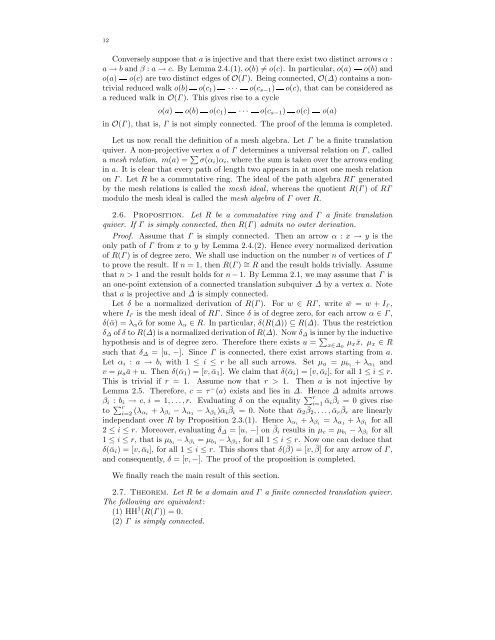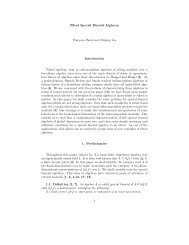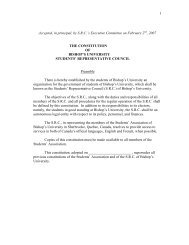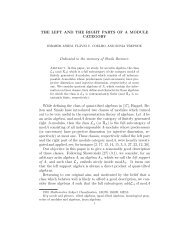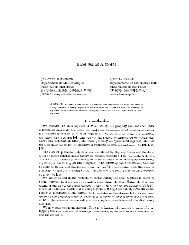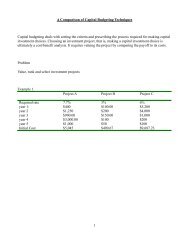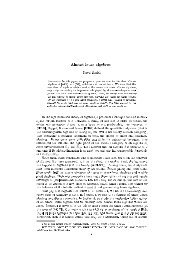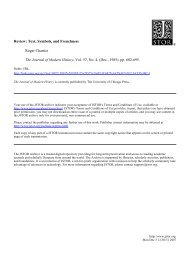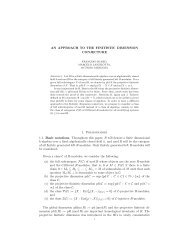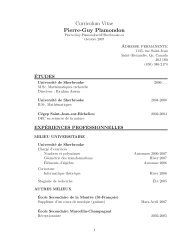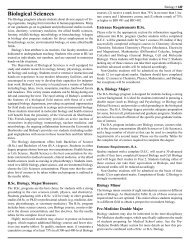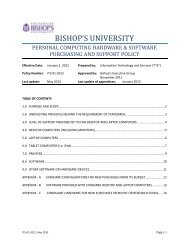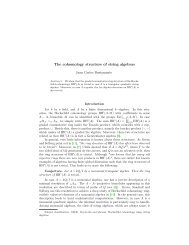Hochschild Cohomology and Representation-finite Algebras Ragnar ...
Hochschild Cohomology and Representation-finite Algebras Ragnar ...
Hochschild Cohomology and Representation-finite Algebras Ragnar ...
Create successful ePaper yourself
Turn your PDF publications into a flip-book with our unique Google optimized e-Paper software.
12<br />
Conversely suppose that a is injective <strong>and</strong> that there exist two distinct arrows α :<br />
a → b <strong>and</strong> β : a → c. By Lemma 2.4.(1), o(b) ≠ o(c). In particular, o(a) o(b) <strong>and</strong><br />
o(a) o(c) aretwodistinctedgesofO(Γ ). Being connected, O(∆) contains a nontrivial<br />
reduced walk o(b) o(c 1 ) ··· o(c s−1 ) o(c), that can be considered as<br />
a reduced walk in O(Γ ). This gives rise to a cycle<br />
o(a) o(b) o(c 1 ) ··· o(c s−1 ) o(c) o(a)<br />
in O(Γ ), that is, Γ is not simply connected. The proof of the lemma is completed.<br />
Let us now recall the definition of a mesh algebra. Let Γ be a <strong>finite</strong> translation<br />
quiver. A non-projective vertex a of Γ determines a universal relation on Γ , called<br />
a mesh relation, m(a) = ∑ σ(α i )α i , where the sum is taken over the arrows ending<br />
in a. It is clear that every path of length two appears in at most one mesh relation<br />
on Γ . Let R be a commutative ring. The ideal of the path algebra RΓ generated<br />
by the mesh relations is called the mesh ideal, whereas the quotient R(Γ )ofRΓ<br />
modulo the mesh ideal is called the mesh algebra of Γ over R.<br />
2.6. Proposition. Let R be a commutative ring <strong>and</strong> Γ a <strong>finite</strong> translation<br />
quiver. If Γ is simply connected, then R(Γ ) admits no outer derivation.<br />
Proof. Assume that Γ is simply connected. Then an arrow α : x → y is the<br />
only path of Γ from x to y by Lemma 2.4.(2). Hence every normalized derivation<br />
of R(Γ ) is of degree zero. We shall use induction on the number n of vertices of Γ<br />
to prove the result. If n =1,thenR(Γ ) ∼ = R <strong>and</strong> the result holds trivially. Assume<br />
that n>1 <strong>and</strong> the result holds for n − 1. By Lemma 2.1, we may assume that Γ is<br />
an one-point extension of a connected translation subquiver ∆ by a vertex a. Note<br />
that a is projective <strong>and</strong> ∆ is simply connected.<br />
Let δ be a normalized derivation of R(Γ ). For w ∈ RΓ ,write ¯w = w + I Γ ,<br />
where I Γ is the mesh ideal of RΓ .Sinceδ is of degree zero, for each arrow α ∈ Γ ,<br />
δ(ᾱ) =λ α ᾱ for some λ α ∈ R. Inparticular,δ(R(∆)) ⊆ R(∆). Thus the restriction<br />
δ ∆ of δ to R(∆) is a normalized derivation of R(∆). Now δ ∆ is inner by the inductive<br />
hypothesis <strong>and</strong> is of degree zero. Therefore there exists u = ∑ x∈∆ 0<br />
µ x¯x, µ x ∈ R<br />
such that δ ∆ =[u, −]. Since Γ is connected, there exist arrows starting from a.<br />
Let α i : a → b i with 1 ≤ i ≤ r be all such arrows. Set µ a = µ b1 + λ α1 <strong>and</strong><br />
v = µ a ā + u. Thenδ(ᾱ 1 )=[v, ᾱ 1 ]. We claim that δ(ᾱ i )=[v, ᾱ i ], for all 1 ≤ i ≤ r.<br />
This is trivial if r = 1. Assume now that r > 1. Then a is not injective by<br />
Lemma 2.5. Therefore, c = τ − (a) exists<strong>and</strong>liesin∆. Hence ∆ admits arrows<br />
β i : b i → c, i =1,...,r. Evaluating δ on the equality ∑ r<br />
i=1 ᾱi ¯β i =0givesrise<br />
to ∑ r<br />
i=2 (λ α i<br />
+ λ βi − λ α1 − λ β1 )ᾱ i ¯βi =0. Note that ᾱ 2 ¯β2 ,...,ᾱ r ¯βr are linearly<br />
independant over R by Proposition 2.3.(1). Hence λ αi + λ βi = λ α1 + λ β1 for all<br />
2 ≤ i ≤ r. Moreover, evaluating δ ∆ =[u, −] on ¯β i results in µ c = µ bi − λ βi for all<br />
1 ≤ i ≤ r, thatisµ bi − λ βi = µ b1 − λ β1 , for all 1 ≤ i ≤ r. Now one can deduce that<br />
δ(ᾱ i )=[v, ᾱ i ], for all 1 ≤ i ≤ r. This shows that δ( ¯β) =[v, ¯β] for any arrow of Γ ,<br />
<strong>and</strong> consequently, δ =[v, −]. The proof of the proposition is completed.<br />
We finally reach the main result of this section.<br />
2.7. Theorem. Let R be a domain <strong>and</strong> Γ a <strong>finite</strong> connected translation quiver.<br />
The following are equivalent :<br />
(1) HH 1 (R(Γ )) = 0.<br />
(2) Γ is simply connected.


